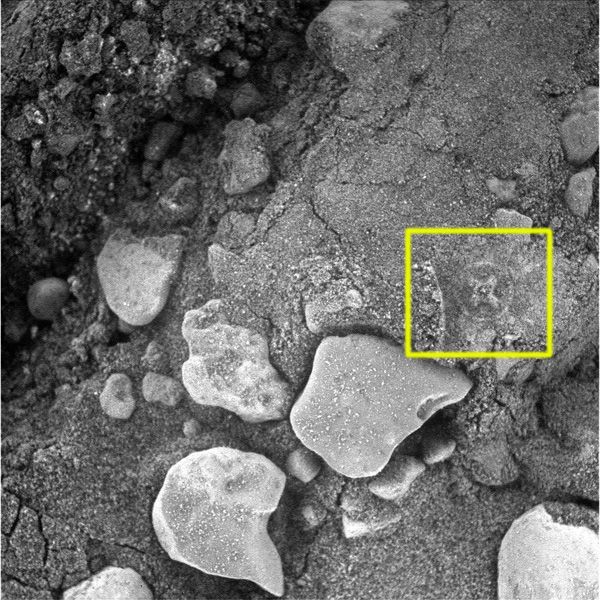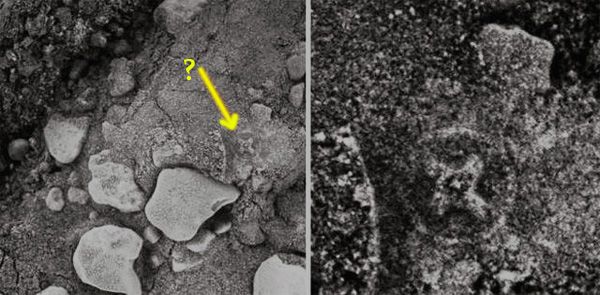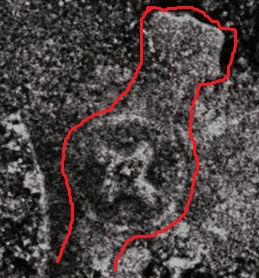It looks like you're using an Ad Blocker.
Please white-list or disable AboveTopSecret.com in your ad-blocking tool.
Thank you.
Some features of ATS will be disabled while you continue to use an ad-blocker.
share:
Guys! This one is quite an anomaly! A 'cross' embedded in Martian rock.
The anomaly, which was spotted in a photograph returned by NASA's Opportunity rover, consists of what looks like a perfect circle with a cross design in the center. However, the circular cross shape happens to bear an uncanny resemblance to the type of screw-heads found in the rover's Alpha particle X-ray Spectrometer tool.
The most likely explanation therefore is that the rover left an unintentional imprint of one of the spectrometer's screw-heads in the rock just before the photograph was taken. But then could the delicate spectrometer's screw-head make such an indentation into solid rock?
If not, then could there be another explanation too? Like an alien artifact embedded into the rock?
Here's the NASA image....


If you look closely, the indentation seems to be made in antiquity. Doesn't seem freshly scooped out!
What do you think?
mars.jpl.nasa.gov...edit on 21-10-2014 by OrionHunterX because: (no reason given)
Here is a picture of the APXS carried on the rover. Notice the screws around the rim? Notice the inner curve of the rim? Notice how the imprint
matches?
mars.jpl.nasa.gov...
The APXS is a "contact instrument" it is is pressed against the material it is analyzing.
mars.jpl.nasa.gov...
The APXS is a "contact instrument" it is is pressed against the material it is analyzing.
edit on 10/21/2014 by Phage because: (no reason given)
Posted & debunked already, sorry my friend. It was a screw imprint from the rover or something.
Already posted. It's an imprint of a screw, and it's in loose sand, not solid rock.
edit on 10/21/2014 by AdmireTheDistance because: (no reason
given)
a reply to: Phage
Its no fun when you make sense of it so fast phage!
Didn't look much like the celtic cross to begin with tho
Well looks like you weren't alone in that aspect
Its no fun when you make sense of it so fast phage!
Didn't look much like the celtic cross to begin with tho
Well looks like you weren't alone in that aspect
edit on stTue, 21 Oct 2014 01:19:28 -0500America/Chicago1020142880 by Sremmos80
because: (no reason given)
I am gonna have to disagree with you Phage, if that were the case the patterns would match or at least be similar and they are not. Nice try though
Debunkosaurus
originally posted by: Phage
a reply to: nrd101
Actually, they do. The screw head. The inner curve of the rim.
Perfect match because that's what made it.
That is why I disagree, in your pic there are many repeating concentric circles that are not present
on the image from mars. In fact, It shows a different cross type pattern.
originally posted by: nrd101
originally posted by: Phage
a reply to: nrd101
Actually, they do. The screw head. The inner curve of the rim.
Perfect match because that's what made it.
That is why I disagree, in your pic there are many repeating concentric circles that are not present
on the image from mars. In fact, It shows a different cross type pattern.
What nrd101 is referring to is the fact that the martian imprint has 4 holes. Phage's image clearly has 6 holes. Because nrd101 and I have superb spacial ability and abstract reasoning skills , we are quickly and accurately able to determine that the patterns do not match.
Spatial visualization ability or visual-spatial ability is the ability to mentally manipulate 2-dimensional and 3-dimensional figures. It is typically measured with simple cognitive tests and is predictive of user performance with some kinds of user interfaces.
I rarely post, but this one is too obvious not too, I think theres more to that martian imprint, star if you agree.
originally posted by: AdmireTheDistance
Already posted. It's an imprint of a screw, and it's in loose sand, not solid rock.
It seems to me that this is especially why there should be an imprint of more than one screw visible. If it is indeed, a screw at all.
a reply to: MoonBlossom
So, it's a recent imprint in the dust? What do you think made it?
Heres a little experiment you can do at home. Make a little pile of cornstarch or something finer. Don't level it out, just a bump of dust. Use a can of soup and push it down on the pile, off center. Not too hard. The can is circular right? Is the impression a circle, or an arc?
www.abovetopsecret.com...
So, it's a recent imprint in the dust? What do you think made it?
Heres a little experiment you can do at home. Make a little pile of cornstarch or something finer. Don't level it out, just a bump of dust. Use a can of soup and push it down on the pile, off center. Not too hard. The can is circular right? Is the impression a circle, or an arc?
www.abovetopsecret.com...
edit on 10/21/2014 by Phage because: (no reason given)
a reply to: OrionHunterX
Interesting picture!
I even see a handle on top of the circular object, angled to the right

Interesting picture!
I even see a handle on top of the circular object, angled to the right

edit on 21-10-2014 by skido because: (no reason given)
The imprint theory doesn't explain the square structure above and below the circular item ...looks like if they were testing they were testing the
long squared structure just covered by the dirt.
a reply to: DooDer
Umm, that screw in the pic you post there looks tiny in comparison to that imprint on Mars..............
Also, the cross section of the screw in your pic doesn't even match that cross imprint.
Umm, that screw in the pic you post there looks tiny in comparison to that imprint on Mars..............
Also, the cross section of the screw in your pic doesn't even match that cross imprint.
edit on 21-10-2014 by Vrill because: (no reason
given)
new topics
-
University of Texas Instantly Shuts Down Anti Israel Protests
Education and Media: 2 hours ago -
Any one suspicious of fever promotions events, major investor Goldman Sachs card only.
The Gray Area: 4 hours ago -
God's Righteousness is Greater than Our Wrath
Religion, Faith, And Theology: 8 hours ago -
Electrical tricks for saving money
Education and Media: 11 hours ago
top topics
-
VP's Secret Service agent brawls with other agents at Andrews
Mainstream News: 13 hours ago, 10 flags -
Cats Used as Live Bait to Train Ferocious Pitbulls in Illegal NYC Dogfighting
Social Issues and Civil Unrest: 17 hours ago, 8 flags -
Nearly 70% Of Americans Want Talks To End War In Ukraine
Political Issues: 13 hours ago, 4 flags -
Sunak spinning the sickness figures
Other Current Events: 13 hours ago, 4 flags -
Electrical tricks for saving money
Education and Media: 11 hours ago, 4 flags -
Late Night with the Devil - a really good unusual modern horror film.
Movies: 15 hours ago, 2 flags -
Any one suspicious of fever promotions events, major investor Goldman Sachs card only.
The Gray Area: 4 hours ago, 2 flags -
University of Texas Instantly Shuts Down Anti Israel Protests
Education and Media: 2 hours ago, 1 flags -
God's Righteousness is Greater than Our Wrath
Religion, Faith, And Theology: 8 hours ago, 0 flags
active topics
-
Nearly 70% Of Americans Want Talks To End War In Ukraine
Political Issues • 47 • : andy06shake -
University of Texas Instantly Shuts Down Anti Israel Protests
Education and Media • 9 • : Vermilion -
Should Biden Replace Harris With AOC On the 2024 Democrat Ticket?
2024 Elections • 50 • : YourFaceAgain -
New whistleblower Jason Sands speaks on Twitter Spaces last night.
Aliens and UFOs • 57 • : baablacksheep1 -
HORRIBLE !! Russian Soldier Drinking Own Urine To Survive In Battle
World War Three • 39 • : crayzeed -
President BIDEN Vows to Make Americans Pay More Federal Taxes in 2025 - Political Suicide.
2024 Elections • 138 • : grey580 -
Sunak spinning the sickness figures
Other Current Events • 15 • : angelchemuel -
British TV Presenter Refuses To Use Guest's Preferred Pronouns
Education and Media • 147 • : Annee -
So this is what Hamas considers 'freedom fighting' ...
War On Terrorism • 260 • : network dude -
Hate makes for strange bedfellows
US Political Madness • 43 • : network dude
